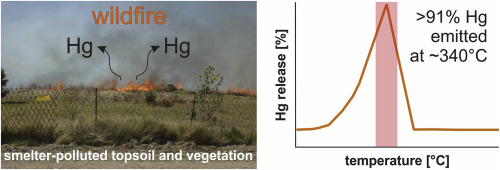当前位置:
X-MOL 学术
›
Chemosphere
›
论文详情
Our official English website, www.x-mol.net, welcomes your feedback! (Note: you will need to create a separate account there.)
The potential wildfire effects on mercury remobilization from topsoils and biomass in a smelter-polluted semi-arid area.
Chemosphere ( IF 8.8 ) Pub Date : 2020-01-21 , DOI: 10.1016/j.chemosphere.2020.125972 Marek Tuhý 1 , Jan Rohovec 2 , Šárka Matoušková 2 , Martin Mihaljevič 1 , Bohdan Kříbek 3 , Aleš Vaněk 4 , Ben Mapani 5 , Jörg Göttlicher 6 , Ralph Steininger 6 , Juraj Majzlan 7 , Vojtěch Ettler 1
Chemosphere ( IF 8.8 ) Pub Date : 2020-01-21 , DOI: 10.1016/j.chemosphere.2020.125972 Marek Tuhý 1 , Jan Rohovec 2 , Šárka Matoušková 2 , Martin Mihaljevič 1 , Bohdan Kříbek 3 , Aleš Vaněk 4 , Ben Mapani 5 , Jörg Göttlicher 6 , Ralph Steininger 6 , Juraj Majzlan 7 , Vojtěch Ettler 1
Affiliation

|
Wildfires can be responsible for significant mercury (Hg) emissions especially in contaminated areas. Here, we investigated the Hg distribution in topsoils and vegetation samples and temperature-dependent Hg mobilization from biomass-rich topsoils collected near a copper (Cu) smelter in Tsumeb (semi-arid Namibia), where Hg-rich Cu concentrates are processed. The thermo-desorption (TD) experiments conducted on representative biomass-rich topsoils (3.9-7.7 mg Hg/kg) indicated that more than 91% of the Hg was released at ∼340 °C, which corresponds to the predominant grassland-fire conditions. The mineralogical investigation indicated that the Hg comes mainly from the deposited smelter emissions because no distinct Hg-rich microparticles corresponding to the windblown dust from the nearby disposal sites of the technological materials (concentrates, slags, tailings) were found. A comparison with the TD curves of the Hg reference compounds confirmed that the Hg in the biomass-rich topsoils occurs as a mixture of Hg bound to the organic matter and metacinnabar (black HgS), which exhibits similarities with the TD pattern of smelter flue dust residue. Despite the installation of a sulfuric acid plant in the smelter in 2015 and a calculated drop in the estimated Hg emissions (from 1301 ± 457 kg/y for the period 2004-2015 to 67 ± 5 kg/y after 2015), the Hg legacy pool in the smelter surroundings can potentially be re-emitted back to the atmosphere by wildfire. Using the Hg spatial distribution data in the area (184 km2), the estimates indicate that up to 303 kg and 1.3 kg can be remobilized from the topsoils and vegetation, respectively.
中文翻译:

潜在的野火对冶炼厂污染的半干旱地区表层土壤和生物质中汞的迁移影响。
野火可能导致大量的汞(Hg)排放,尤其是在受污染的地区。在这里,我们调查了在楚梅布(半干旱纳米比亚)的一座铜冶炼厂附近收集的,富含汞的铜精矿加工地表土和植被样品中汞的分布以及从富含生物质的表土中汞的迁移过程。对代表性的富含生物质的表层土壤(3.9-7.7 mg Hg / kg)进行的热脱附(TD)实验表明,超过340%的Hg释放出91%的Hg,这对应于主要的草原着火条件。矿物学研究表明,汞主要来自冶炼厂的沉积物,这是因为没有来自附近技术材料处置场(浓缩物,炉渣,尾矿)被发现。与汞参考化合物的TD曲线的比较证实,富含生物质的表土中的汞是与有机物结合的汞与后朱砂(黑色HgS)的混合物,与冶炼厂烟道气的TD规律相似。残留物。尽管2015年在冶炼厂安装了硫酸工厂,并且汞的估算排放量已计算出下降(从2004-2015年的1301±457千克/年降至2015年后的67±5千克/年),但汞的遗留问题冶炼厂周围的游泳池可能会因野火而重新排放到大气中。利用该地区(184 km2)的汞空间分布数据,估计值表明,分别可以从表土和植被中转移出303 kg和1.3 kg。与汞参考化合物的TD曲线的比较证实,富含生物质的表土中的汞是与有机物结合的汞与后朱砂(黑色HgS)的混合物,与冶炼厂烟道气的TD规律相似。残留物。尽管2015年在冶炼厂安装了硫酸工厂,并且汞的估算排放量已计算出下降(从2004-2015年的1301±457千克/年降至2015年后的67±5千克/年),但汞的遗留问题冶炼厂周围的游泳池可能会因野火而重新排放到大气中。利用该地区(184 km2)的汞空间分布数据,估计值表明,分别可以从表土和植被中转移出303 kg和1.3 kg。与汞参考化合物的TD曲线的比较证实,富含生物质的表土中的汞是与有机物结合的汞与后朱砂(黑色HgS)的混合物,与冶炼厂烟道气的TD规律相似。残留物。尽管2015年在冶炼厂安装了硫酸工厂,并且汞的估算排放量已计算出下降(从2004-2015年的1301±457千克/年降至2015年后的67±5千克/年),但汞的遗留问题冶炼厂周围的游泳池可能会因野火而重新排放到大气中。利用该地区(184 km2)的汞空间分布数据,估计值表明,分别可以从表土和植被中转移出303 kg和1.3 kg。
更新日期:2020-01-21
中文翻译:

潜在的野火对冶炼厂污染的半干旱地区表层土壤和生物质中汞的迁移影响。
野火可能导致大量的汞(Hg)排放,尤其是在受污染的地区。在这里,我们调查了在楚梅布(半干旱纳米比亚)的一座铜冶炼厂附近收集的,富含汞的铜精矿加工地表土和植被样品中汞的分布以及从富含生物质的表土中汞的迁移过程。对代表性的富含生物质的表层土壤(3.9-7.7 mg Hg / kg)进行的热脱附(TD)实验表明,超过340%的Hg释放出91%的Hg,这对应于主要的草原着火条件。矿物学研究表明,汞主要来自冶炼厂的沉积物,这是因为没有来自附近技术材料处置场(浓缩物,炉渣,尾矿)被发现。与汞参考化合物的TD曲线的比较证实,富含生物质的表土中的汞是与有机物结合的汞与后朱砂(黑色HgS)的混合物,与冶炼厂烟道气的TD规律相似。残留物。尽管2015年在冶炼厂安装了硫酸工厂,并且汞的估算排放量已计算出下降(从2004-2015年的1301±457千克/年降至2015年后的67±5千克/年),但汞的遗留问题冶炼厂周围的游泳池可能会因野火而重新排放到大气中。利用该地区(184 km2)的汞空间分布数据,估计值表明,分别可以从表土和植被中转移出303 kg和1.3 kg。与汞参考化合物的TD曲线的比较证实,富含生物质的表土中的汞是与有机物结合的汞与后朱砂(黑色HgS)的混合物,与冶炼厂烟道气的TD规律相似。残留物。尽管2015年在冶炼厂安装了硫酸工厂,并且汞的估算排放量已计算出下降(从2004-2015年的1301±457千克/年降至2015年后的67±5千克/年),但汞的遗留问题冶炼厂周围的游泳池可能会因野火而重新排放到大气中。利用该地区(184 km2)的汞空间分布数据,估计值表明,分别可以从表土和植被中转移出303 kg和1.3 kg。与汞参考化合物的TD曲线的比较证实,富含生物质的表土中的汞是与有机物结合的汞与后朱砂(黑色HgS)的混合物,与冶炼厂烟道气的TD规律相似。残留物。尽管2015年在冶炼厂安装了硫酸工厂,并且汞的估算排放量已计算出下降(从2004-2015年的1301±457千克/年降至2015年后的67±5千克/年),但汞的遗留问题冶炼厂周围的游泳池可能会因野火而重新排放到大气中。利用该地区(184 km2)的汞空间分布数据,估计值表明,分别可以从表土和植被中转移出303 kg和1.3 kg。



























 京公网安备 11010802027423号
京公网安备 11010802027423号